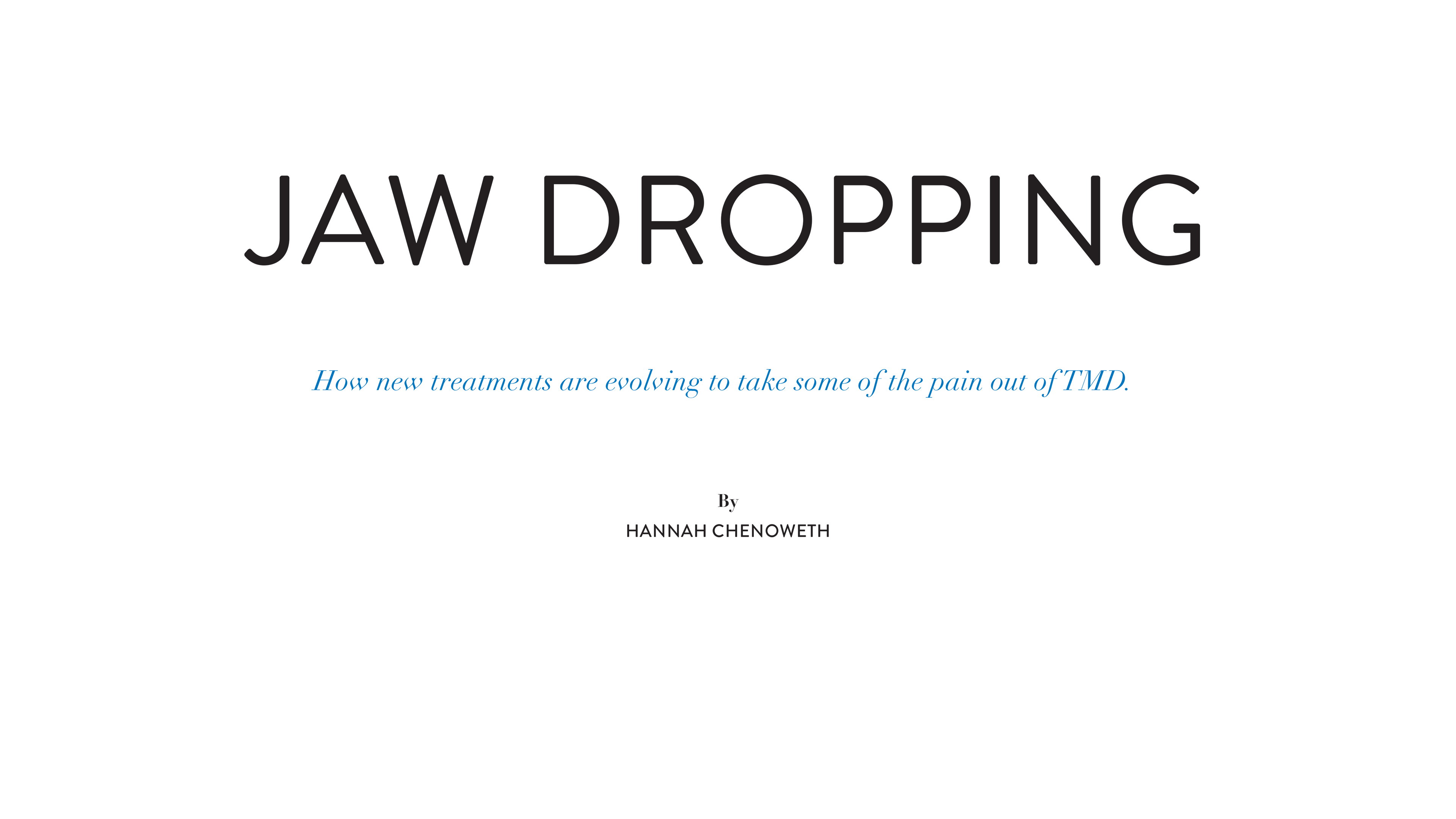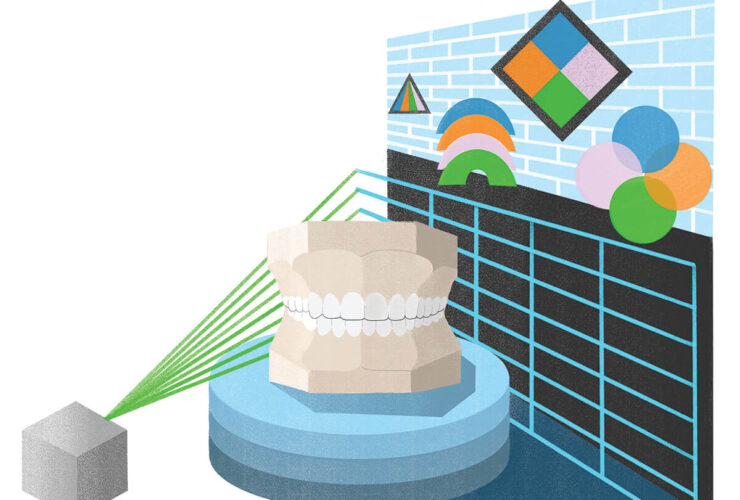
Jaw Dropping
How new treatments are evolving to take some of the pain out of TMD.
By Hannah Chenoweth

or almost a decade, foods like pizza or bagels were off-limits for Baltimore resident Megan Karanfil. Hard foods made her jaw lock in place, causing excruciating pain. As Karanfil found out through her years-long journey, problems with one’s temporomandibular joint (TMJ) are life-changing.
“It was truly an awful experience,” says Karanfil. “You don’t realize just how much jaw pain can impact your life until it happens to you.”
The TMJ may be one of the most frequently used joints, but it’s fairly misunderstood.
In fact, the misconceptions begin with the name itself.
“A lot of patients say they are coming to me for TMJ,” says Dr. Marcela Romero-Reyes, a clinical professor at the University of Maryland School of Dentistry. “The TMJ is a joint, so that’s like saying you have an elbow or knee.”
What patients like Karanfil are dealing with is a temporomandibular joint disorder, TMD for short. This is an umbrella term for more than 30 conditions that affect the TMJ and surrounding tissue.
What makes the TMJ unique is the fact there are two joints in one (one on both sides of your face), and both must move in coordination with each other. At the same time, they must provide different types of movement and a wide range of combined functions. This joint may be complex, but finding it is easy: Just place your fingers in front of your ears and open your mouth. You’ll feel the two TMJs, which connect your lower jaw to your skull.
These tiny joints help you with countless muscle actions—chewing, talking, yawning, laughing, swallowing, even making facial expressions—that you likely don’t think twice about. But if you’re one of as many as 11 to 12 million adults in the United States who experience dysfunction in this area, you know just how disruptive it can be to the daily activities the rest of us take for granted.
So, who is at risk for TMD? According to Dr. Gary Warburton, clinical professor and chair of oral and maxillofacial surgery at University of Maryland School of Dentistry, it’s most prevalent among women, especially those in their mid-30s. Although there are several theories, from the anatomical to the hormonal, there’s still no consensus on why women are more likely to have TMD.
Treatment depends on the root cause—which, frustratingly, isn’t always clear, though it typically manifests due to jaw strain, trauma to the jaw from an injury, or with systemic arthritis. Still, symptoms can also arise without an obvious cause and may even be caused by the surrounding muscles instead of the TMJ itself.
In Karanfil’s case, it took years for a physical therapist to discover that her jaw pain stemmed from tension points in her neck. Only after the physical therapist did something called a manual neck release—a chiropractic-style neck manipulation—and taught Karanfil how to do jaw releases on her own, did Karanfil finally find relief.
While some patients experience locking in the jaw like Karanfil, others experience difficulty opening it in the first place. Romero-Reyes says that other common symptoms include discomfort and soreness in the jaw, facial and neck pain, headaches, and earaches. You may also experience a painful popping or clicking in the jaw. “We’re learning that some of these symptoms can overlap or be made worse by other conditions, such as migraines,” she says.
For some people, these symptoms are mild and go away on their own—sometimes even within the span of booking an appointment. For others, like Karanfil, TMD can become a chronic and even debilitating issue.
While the spectrum of severity varies, the experts all agree: Behavior modifications are the first line of treatment. Dr. Stephen Gamerman, who specializes in TMJ pain and practices in Towson and Laurel, takes the KISS approach (“Keep it simple, stupid”).
“I always recommend that patients keep a pain journal to track their behavior throughout the day,” he says. “This is an excellent way to examine the contributing factors that may be behind your pain. If it’s 2 p.m. and your jaw is bothering you, we can then look at what you did at 1 p.m.”
One common contributor is stress, since this can lead to habits like jaw clenching and teeth grinding. While mouth guards might not be glamorous, evidence shows that they can help encourage the jaw to relax during the night (particularly if your TMJ pain is at its worst in the morning). Your dentist may recommend that you explore other ways to manage stress during the day, too, like relaxation techniques or cognitive behavioral therapy.
And just like you would rest a sprained ankle, it’s vital to give your jaw a rest. This means that chewy and crunchy foods are a nono (gum included), nail-biting needs to stop, and you should try to curb excessive talking or singing. Steroids and muscle relaxers can help ease the pain during flare-ups, as well as moist heat applied to the area.
“Treatment isn’t one-size-fits-all, but there are several different tools we can offer to a patient,” says Romero-Reyes. “We are still learning and researching TMD, but non-invasive treatments are really the standard now. Only a very low percentage of patients will end up needing surgery.”
Some of the tools in a patient’s “TMD toolbox” extend past the dental office. For Karanfil, physical therapy wasn’t her first stop, but it ended up being the solution. The TMJ is a joint just like any other, after all, and physical therapists are experts in motion of the joints.
Ryan Lynch, founder of Lynch Physical Therapy (located in Towson and Severna Park), specializes in the treatment of TMJ pain. “You wouldn’t go to a surgeon right away if you had knee pain, and it’s the same with TMD,” he says. “Physical therapy is conservative care that can be extremely effective at reducing TMJ pain.”
What’s tricky, Lynch explains, is the tug-of-war between needing to relax the TMJs and needing to use them all day. Since you can’t exactly give up daily functions like talking and eating, it can be more challenging than resting a joint like the knee.
Just as the dentists will tell you, Lynch emphasizes lifestyle modifications to avoid irritating the jaw, particularly when it comes to posture. The vast majority of TMD patients he sees have cervical dysfunction, which makes sense: Poor posture, which can have many causes, including “tech neck” (the forward slouch many of us adopt while looking at our phones), places stress on the jaw, and the latest research confirms the direct relationship between muscles in the neck and TMJ pain.
Typically, Lynch starts patients off with moist heat and electrical stimulation to help with pain reduction and preparing the area for more advanced treatments. Then, he’ll move on to modalities like cold laser therapy, manual therapy, and dry needling.
“With cold laser therapy, it’s the same philosophy as laser hair removal. But instead of the laser affecting the hair follicles, the frequency is manipulated to be anti-inflammatory,” says Lynch. “It’s a painless treatment that involves a small wand and takes just a few minutes per session.”
Dry needling isn’t quite as comfortable, but Lynch says it’s not “unbearable” either. It might sound like acupuncture, but the only similarity is that both use solid needles (meaning there’s no hole in them). This technique aims to address persistent and painful muscle knots by inserting a needle directly at a myofascial knot or adhesion.
“By the time most patients get to me, they’re just ready for relief. I’d say dry needling is a game-changer for about two-thirds of my patients,” says Lynch.
Each of these treatments has their benefits, depending on the patient. Because the TMJ is a superficial joint (without tissue blocking access to it), cold laser therapy is able to penetrate deep into the joint to reduce inflammation. Then there’s manual therapy, which works the muscles and soft tissue structures of the neck and jaw to reduce TMJ pain and reduce muscle adhesions. Dry needling, too, is great for precisely pinpointing muscle knots that we can’t access with hands.
According to Romero-Reyes, education and awareness are absolutely crucial to empowering patients—especially because TMD tends to be cyclical and resurface in times of stress.
“Treatment isn’t one-size-fits-all, but there are several different tools we can offer to a patient . . . we are still learning and researching TMD, but non-invasive treatments are really the standard now.”
When it comes to the future, she finds it incredibly promising that in March 2020, orofacial pain was recognized by the American Dental Association as a specialty. This means more dental students than ever are specializing in orofacial disorders like TMD and expanded training and research opportunities will continue to improve the quality of care.
Gamerman is also encouraged by the increase in TMD as a specialty for the next generation of dental students.
“Back in the 1980s, no one wanted to know about TMD,” he says. “The behavioral analysis that’s occurring today is so refreshing. We’re learning that TMD is so much more than just mouth guards.”






